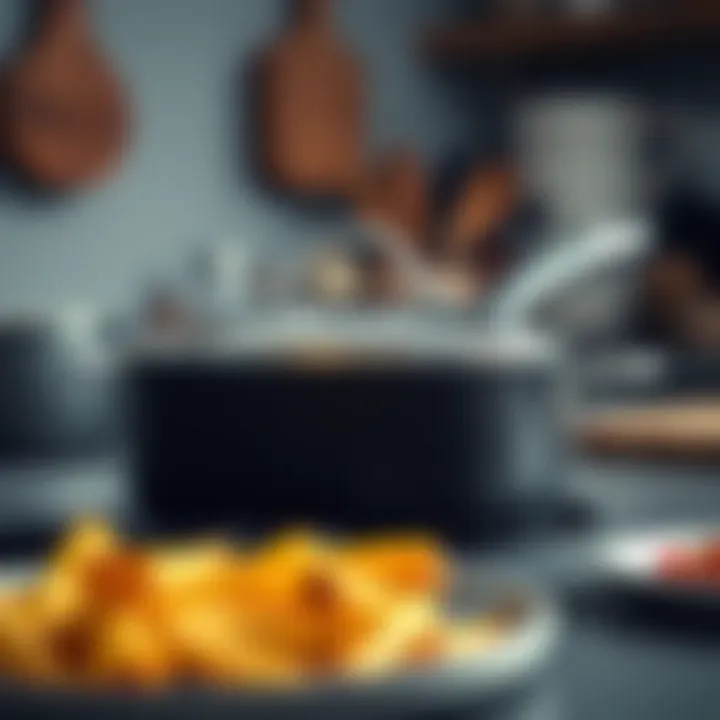Assessing the Risks of Non-Stick Cookware Safety


Intro
In the world of culinary arts, the choice of cookware significantly affects both the cooking experience and the health implications of the meals we prepare. Non-stick cookware, known for its ease of use and maintenance, has become a staple in many kitchens. However, the question of its safety has sparked considerable debate.
Many consumers are left in a quandary over whether non-stick pans are a convenient tool or a potential hazard in their culinary routines. As we peel back the layers of this topic, we find a blend of chemistry and health discussions that can make even the most seasoned cook reconsider their kitchen arsenal.
Let's not mince words; the materials used in non-stick coatings, primarily polytetrafluoroethylene (PTFE) and perfluorooctanoic acid (PFOA), have raised red flags among researchers and health experts. This article sets out to unravel the intricate narratives surrounding the toxicity of non-stick cookware, examining both the scientific studies and anecdotal evidence that have emerged over the years.
Through an analytical lens, we will explore the nuances of these materials, their interactions with food, and the risks posed at various temperatures. Additionally, for those who find themselves needing alternatives or modifications to their cooking routines, we will provide practical solutions that don't sacrifice convenience for safety. Pack your curiosity and let's dive deeper into the layers of this contentious subject.
The Rise of Non-Stick Cookware
Non-stick cookware has become a staple in many kitchens worldwide. The ease of cooking and cleaning associated with these pots and pans has fundamentally changed how meals are prepared. The ability to flip an omelet without it sticking, or to brown chicken without any oil, makes cooking less of a chore for many. This convenience has led to an upward trend in the popularity of non-stick products, but this rise is not solely due to cookery ease.
Non-stick coatings emerged largely as a response to an increasing demand for more efficient cooking solutions. Traditionally, cooking involved pots and pans that required more oil or butter, leading to a greasy mess often left behind. The introduction of non-stick coatings allows for healthier cooking options, as they provide a surface that reduces the need for these fats, positioning them as a preferred choice in various diets.
Yet, there are considerations to keep in mind. The safe usage and longevity of these products have come under scrutiny, especially as more consumers become aware of the materials involved in these coatings. As the article delves into this exploration, it questions not only the practicality of using non-stick cookware but also its long-term impacts on health and well-being. This leads us to assess how the past has shaped today’s non-stick cookware options.
Historical Development
The journey of non-stick cookware began in the late 20th century. The early 1950s saw the rise of polytetrafluoroethylene (PTFE) as a revolutionary material. Teflon, the most recognized brand associated with this compound, quickly became synonymous with non-stick cookware. People embraced it, repulsed by the hassle of cleaning traditional cookware.
As the popularity soared, so did the number of manufacturers jumping on the non-stick bandwagon. The sleek, dark, and shiny appearance of non-stick coated pans tailored to the modern kitchen aesthetic made them even more desirable. However, along with these conveniences emerged questions about safety and toxicity, particularly when concerns about one of Teflon’s components, perfluorooctanoic acid (PFOA), started to come to light in the late 1990s.
Technological Advancements
In the years following its inception, there have been significant technological advancements in non-stick cookware. New formulations were developed, improving the durability and heat resistance of non-stick coatings. Innovations included the introduction of ceramic coatings, which aimed at avoiding the chemicals associated with PTFE, presenting a safer alternative.
Many brands now tout their products as PFOA-free, addressing health concerns while maintaining the functionality that has made non-stick cookware immensely popular. The quest for better technology continues, as manufacturers explore the use of eco-friendly materials while enhancing non-stick capabilities.
The constant evolution of technologies in cookware not only promises better cooking experiences but also reflects consumer demand for safer, more responsible cookware options.
The history and advancements of non-stick cookware illustrate a balancing act between utility and safety. Understanding this context paves the way for a deeper exploration into the health implications associated with these widely used kitchen items.
Understanding Non-Stick Coatings
The proliferation of non-stick cookware in modern kitchens can’t be overstated. Before one dives into the boiling cauldron of concerns — especially regarding health — it is vital to grasp what non-stick coatings actually entail. Understanding these materials helps consumers make informed decisions. Not only does it demystify the science, but it also sheds light on the potential risks and benefits that come with everyday cooking.
Common Materials Used
Each non-stick product has its own story, woven with various materials that give it its characteristics. Below, I will cover the most prevalent materials used in non-stick coatings today.
Polytetrafluoroethylene (PTFE)
PTFE, commonly known by the brand name Teflon, is perhaps the most recognized material in the non-stick cookware realm. A significant aspect of PTFE is its remarkable ability to resist sticking, which is why it graces the cooking surfaces of millions around the globe. One key characteristic of PTFE is its high heat resistance, allowing it to withstand temperatures generally used in home cooking without degrading.
However, there’s a flip side. While PTFE itself is generally regarded as safe, when subjected to high temperatures above 500°F, it can release harmful fumes that could be detrimental to both humans and pets. This unique feature makes it a popular but also controversial choice for those concerned about safety in their cooking practices.
- Advantages: Excellent non-stick properties, easy to clean.
- Disadvantages: Symptoms of fume fever can arise from overheating, potential for degradation over time.
Perfluorooctanoic acid (PFOA)
PFOA, on the other hand, has been the focus of significant scrutiny and debate in recent years. While it plays a role in the manufacturing process of PTFE coatings, its health implications cannot be overlooked. An important aspect of PFOA is its potential link to various health concerns, including certain types of cancer and liver damage.


Because of increased public awareness and regulatory pressures, many manufacturers have phased out PFOA from their production processes. Consumers should be aware of this component as it was commonly found in older non-stick products.
- Advantages: Historically used to improve the non-stick quality of cookware.
- Disadvantages: Long exposure can lead to serious health risks, now largely phased out in many regions.
Other Chemical Alternatives
As PFOA becomes a thing of the past, the hunt for safer alternatives is ongoing. Several cookware brands are now utilizing alternative materials, such as ceramic-based coatings, silicone, or reinforced non-stick surfaces. What stands out about these alternatives is their focus on safety without sacrificing functionality.
These alternatives often boast features like being free from harmful chemicals, leading to a more environmentally friendly product. However, their non-stick properties might not be as durable as those of traditional non-stick coatings, requiring careful handling to prolong their lifespan.
- Advantages: Often safer and chemical-free.
- Disadvantages: May not offer the same level of stick resistance or durability.
Manufacturing Processes
Let’s turn our attention to how these materials come to life. The manufacturing processes of non-stick cookware can play an substantial role in determining the safety and efficacy of the final product. Understanding these processes is key to appreciating what we use in our kitchens. From the initial selection of raw materials to the final quality controls, every step is pivotal in ensuring that consumers are acquiring a product not only capable of high performance but also aligned with health considerations.
Here, a variety of methods might be employed ranging from spray-coating techniques to layering specific chemical formulations. Each of these methodologies may impact the overall integrity and safety of the cookware we put on our stoves.
In summary, grasping the intricacies of non-stick coatings involves delving deeper into the materials, manufacturing processes, and their lasting impacts on health and safety. As the awareness around these coatings continues to grow, it’s essential for consumers to remain vigilant and educated, making choices that align with their culinary needs and safety standards.
Health Considerations
Exploring the health implications of non-stick cookware is crucial for anyone who spends time in the kitchen. With cooking being an essential part of daily life, understanding the potential risks associated with these popular pans is more than just an academic exercise—it’s about your well-being and that of your loved ones. As consumers become more savvy and health-conscious, recognizing what lurks behind the glossy surface of non-stick cookware takes precedence.
Potential Toxicity Risks
Effects of High Temperatures
When discussing the effects of high temperatures on non-stick cookware, one cannot overlook the characteristics of the polytetrafluoroethylene (PTFE) coating that most non-stick pans have. Generally, these pans perform well at typical cooking temperatures, but they can become a problem at higher heats. When PTFE is heated above 500°F (260°C), it can start to break down, releasing harmful fumes that can lead to various health issues. A noteworthy aspect to mention is the specific gases emitted when the temperature spikes. These fumes can cause flu-like symptoms in humans and can be fatal to birds. It's clear that while non-stick pans make cooking easier, they can come with hidden dangers.
Chemical Leaching into Food
Chemical leaching is another significant concern surrounding non-stick cookware. Essentially, this refers to the process where chemicals from the non-stick surface seep into the food, particularly during high-heat cooking or if the cookware is scratched. This can happen with PTFE as well as with other materials used in coatings. The leached substances can be of various natures—some harmful, others not so much. Commonly discussed is perfluorooctanoic acid (PFOA), a substance once prevalent in the manufacturing of Teflon and other non-stick coatings. PFOA has been linked to several health problems, including liver damage and potential reproductive issues.
- It’s crucial to consider the physical integrity of non-stick pans, as scratches can exacerbate the problem of chemical leaching.
In light of these factors, consumers must remain mindful about their choices and usage of non-stick cookware, monitoring both the physical condition of their pans and the temperatures at which they cook.
Scientific Studies and Findings
Numerous scientific studies back the claims of potential health risks associated with non-stick cookware. Research has highlighted a range of concerns from simple discomfort to severe health implications. For example, studies show that prolonged exposure to high heat can accelerate the degradation of the coatings, leading to more emissions of harmful substances. It's beneficial for any informed consumer to dive into these findings to fully grasp the potential effects on health.
Regulatory Perspectives
FDA Regulations
The regulatory framework surrounding non-stick cookware primarily involves oversight from the FDA, which aims to ensure the safety and efficacy of kitchen products. While the FDA monitors food safety closely, their regulations concerning cookware do not always keep pace with scientific advancements and emerging research. One of the critical aspects of FDA regulations is the safety assessment of chemical substances used in manufacturing processes. This regulatory approach helps to safeguard consumer health, yet many critics argue that more stringent measures should be in place.
- Furthermore, the FDA's limited capacity to regulate the long-term impact of cookware remains a significant concern, as public health relies heavily on accountability in manufacturing practices.
International Standards
International standards also provide avenues for assessing the safety of non-stick cookware. Various countries have developed their own regulations which might be stricter than those enforced by the FDA. For example, the European Union has actively banned the use of PFOA in manufacturing non-stick products, reflecting a growing recognition of health risks. These international norms aim to protect consumers and ensure a safer culinary environment.


- Nonetheless, the effectiveness of these regulations can vary widely, and it remains paramount for consumers to stay informed and choose accordingly.
Ultimately, the juxtaposition of these health considerations against practical usage remains a significant topic in the growing discourse around kitchen safety.
Consumer Sentiments
Understanding consumer sentiments plays a pivotal role in shaping the ongoing conversation about non-stick cookware. The feelings, beliefs, and preferences of everyday users not only influence purchasing decisions but also highlight crucial considerations regarding health and safety. In an era where informed choices are becoming increasingly valued, consumers are more aware of the risks associated with the products they use, especially in the kitchen, a space closely tied to health and nourishment. Thus, their voices present significant insight into the overall perception of non-stick cookware.
Market Trends
Growing Concerns
Among the major narratives in consumer sentiments are the growing concerns surrounding the safety of traditional non-stick cookware materials. Many buyers are becoming increasingly wary of health implications linked to chemical exposure. This swell of unease can be attributed to several incidents where studies revealed harmful outcomes connected to certain non-stick coatings. As a response, potential customers are scrutinizing products more closely, looking for transparency regarding their composition.
A significant aspect of these growing concerns is the rise in discussions about potential toxicity of materials such as PTFE and PFOA. Evidence from various scientific studies has backed these apprehensions, making buyers wiser to the possibility of toxic chemicals leaching into their food. This shift signifies a conscientious approach to cooking that prioritizes safety, driving consumers to seek cookware that aligns with their health goals.
"More and more, people want to know what they’re cooking on; they want to make better choices for both their health and the environment."
Shifts Toward Safer Alternatives
In light of these concerns, an evident trend is the shift towards safer alternatives. Consumers are increasingly open to considering products made from non-toxic materials and those manufactured with alternative coatings. Material options such as stainless steel, cast iron, and ceramic-coated cookware have surged in popularity, reflecting a marked change in consumer preferences.
What makes these alternatives appealing is the perception of safety and durability they possess. Unlike traditional non-stick pans that may degrade over time, these materials promise longevity without the shipment of chemicals into the food being prepared. Furthermore, they often provide better cooking performance when it comes to heat retention and distribution.
However, potential drawbacks remain. Some users may feel that these alternative materials do not offer the same convenience in terms of ease of cleaning or food release as non-stick cookware. This sentiment reveals the ongoing negotiation consumers experience when balancing health and practicality in their cooking processes.
Consumer Testimonials
Exploring real-life experiences of individuals who have transitioned away from conventional non-stick options further emphasizes shifts in the market. Testimonials reveal a complex tapestry of sentiments. Some users report a newfound satisfaction with the performance of their chosen alternatives, noting that while they may require different cooking techniques, the trade-offs often appeal to their desire for safer cooking environments. Others share their frustrations over the learning curve that comes with new materials but express a commitment to long-term health benefits.
In summary, consumer sentiments are a dynamic force in the discussion on non-stick cookware. As more people voice their concerns and preferences, the market landscape adjusts, responding to the weight of informed choices. Acknowledging these sentiments is critical as they illuminate the path toward safer cooking alternatives that better align with the health-conscious attitudes of today's consumers.
Alternatives to Non-Stick Cookware
When it comes to culinary creations, the choice of cookware can significantly affect the healthiness of your meals. As more people become aware of the potential risks associated with non-stick surfaces, there is a growing interest in alternatives. It’s clear that selecting the right cookware is vital for both safety and cooking efficiency. Here’s a closer look at three popular alternatives: stainless steel, cast iron, and ceramic coatings. Each of these options comes with its own set of benefits and considerations that cater to various cooking styles and preferences.
Stainless Steel
Stainless steel cookware is often hailed for its durability and versatility. Stainless steel pans can endure high heat and resist warping, which makes them a favorite among professional chefs. One of the significant advantages is the fact that they don’t leach chemicals into food, providing a cleaner cooking experience.
"Stainless steel provides a non-reactive surface, meaning you can cook acid-rich foods, like tomatoes, without concern over off-flavors or harmful reactions."
However, these pans have a tendency to stick, especially when cooking items like eggs or fish. To mitigate this, it’s essential to preheat the pan properly and use adequate oil or fat. Like using a well-oiled skillet can go a long way in enhancing the cooking experience. Plus, they’re easy to clean and maintain, often being dishwasher safe, which is a big bonus for busy home cooks.
For those looking to embrace their culinary skills while avoiding the complications associated with chemically treated surfaces, stainless steel is certainly worthy of consideration.
Cast Iron
Cast iron cookware has been a staple in kitchens for generations. Its ability to retain heat and provide even cooking makes it ideal for slow cooking and frying. Moreover, cast iron can add a subtle amount of iron to your meals, which can be beneficial for health, particularly for those who are iron deficient.
When properly seasoned, cast iron has a natural non-stick surface that's perfect for a variety of dishes, from savory skillets to baked goods like cornbread. One of the draws of cast iron is its longevity; with proper care, these pans can last a lifetime and even be passed down through generations. Nevertheless, cast iron does require regular maintenance, such as seasoning to prevent rust and ensure its surface remains non-stick.
This cookware may seem heavy to some, but its even heating and unmatched heat retention attributes make it a worthy trade-off for any serious cook.
Ceramic Coatings


Ceramic-coated pans are often touted as a safer alternative to traditional non-stick options. Free of PTFE and other harmful chemicals, these pans offer a non-stick surface that is easier for food release.
Ceramic coatings provide a wide range of cooking temperatures, allowing for smooth transitions from stovetop to oven. They can be visually appealing too, often available in a variety of colors and designs. However, they do have a lifespan and can wear out quicker than stainless steel or cast iron, especially if extreme heat is frequently applied.
It’s crucial to use utensils that won't scratch the surface, as this could compromise the coating and lead to food sticking over time. Maintaining ceramic cookware typically involves gentle washing and avoiding harsh abrasives.
In summary, the alternatives to non-stick cookware offer a wealth of options that cater to various culinary needs. By selecting the right kind, one can enjoy cooking without sacrificing health and safety. As you explore these materials, keep in mind their unique characteristics and how they fit into your cooking habits. Consider transitioning slowly and experimenting to find the best fit for your kitchen!
Best Practices for Using Non-Stick Cookware
When it comes to non-stick cookware, knowing how best to utilize it can make a remarkable difference. While these pots and pans offer convenience in the kitchen, the potential hazards surrounding them warrant a careful approach to their usage. Practicing safe methods when cooking can not only preserve the lifespan of the cookware but also minimize any health risks associated with chemical coatings.
Most importantly, understanding how temperature affects the non-stick surface is crucial. Using non-stick cookware properly leads to a more enjoyable cooking experience, while ensuring that meals are prepared safely.
Safe Cooking Temperatures
Cooking at the right temperature is like knowing when to turn up the heat on a good conversation; it can make all the difference. Non-stick coatings, especially those made with polytetrafluoroethylene (PTFE), can break down when they reach excessive temperatures—typically around 500°F (260°C). At this point, they can release toxic fumes that are potentially harmful if inhaled. Keeping this in mind, it’s best to cook on low to medium heat to keep your kitchen safe and your food healthy.
Here are some tips to follow:
- Avoid Preheating Empty Pans: Always ensure that there’s food or oil in the pan before turning on the heat.
- Use Temperature Control: Keep an eye on the stovetop settings. Cooking on medium heat is often sufficient for most dishes.
- Invest in an Infrared Thermometer: This handy gadget can help monitor the temperature of your cookware accurately.
Choosing the Right Utensils
Selecting the proper utensils when using non-stick cookware is akin to choosing the right tools for a creative endeavor. Non-stick surfaces are delicate; using the wrong kind of utensils can scratch or damage them. Steel spatulas and knives are the enemy here, as they can easily ruin the coating. Instead, opt for utensils made from silicone, wood, or plastic.
Here’s a short checklist to consider:
- Silicone Spatulas: They are heat-resistant and won’t scratch.
- Wooden Spoons: They add a rustic flair without causing damage.
- Plastic Utensils: Check for heat resistance to avoid melting.
Proper Care and Maintenance
Once the cooking is done, maintaining your non-stick cookware should be a priority. Proper care can extend its life and keep it performing at its best. Cleaning should never be a hasty affair. Here’s how to make care and maintenance a breeze:
- Let it Cool: Avoid putting a hot pan in cold water—the sudden change can warp the metal.
- Gentle Cleaning Products: Use mild detergent and a soft sponge. Avoid those harsh abrasives that can scratch.
- Store with Care: Never stack non-stick pans directly on top of each other without something in between to protect the coating.
- Inspect Regularly: Keep an eye out for any peeling or scratching, which may indicate it’s time for replacement.
Investing in the best practices for safe usage of non-stick cookware can significantly mitigate health risks and enhance your cooking experience. Keeping informed is key to staying safe in the kitchen.
These best practices not only ensure a healthy cooking environment but also enhance the durability of your non-stick cookware. Cooking can be an enjoyable adventure, and by adhering to these principles, you’ll make the most of your culinary journey.
The End: Informed Choices in Cookware
In navigating the complexities of non-stick cookware, understanding the risks and benefits becomes crucial for making informed choices. The previous discussions on toxicity, materials, and health implications have laid a solid foundation. It’s essential to synthesize this information in the context of everyday use and culinary enjoyment.
Evaluating Risks vs. Benefits
When it comes to non-stick cookware, the age-old adage "no pain, no gain" rings true. Many people love these pans for their ease of use and cleanup, but lurking beneath the convenience is a medley of risks that require evaluation.
- Toxicity Awareness: Knowledge of the materials such as PTFE and PFOA is vital. While many manufacturers have phased out PFOA, the possibility of chemical leaching still exists in higher temperatures.
- Cooking Techniques: The type of food and the cooking method can significantly affect the toxic emissions. Frying or searing at high temperatures can exacerbate these dangers.
- Comparative Analysis: Consider the trade-offs of durability against potential health hazards. Non-stick cookware is often less durable than stainless steel or cast iron.
Ultimately, assessing whether the ease of cooking is worth the potential toxicity can help consumers make well-rounded decisions dependent on individual cooking habits. Some may choose non-stick for their convenience, while others might steer clear, prioritizing safety over simplicity.
Encouraging Safe Practices
A key takeaway from this exploration should be the promotion of prudent practices in the use of non-stick cookware. By encouraging actionable steps, consumers can minimize any associated risks:
- Follow Manufacturer Instructions: Always adhere to the temperature guidelines provided by the manufacturer. Avoid preheating empty pans, as that’s a surefire way to trigger those toxic fumes.
- Use Appropriate Utensils: Opt for silicone, wood, or bamboo utensils that won’t scratch the non-stick surface. Metal utensils can lead to damage, increasing leaching risk.
- Regular Inspections: Keep an eye on your cookware’s condition. If coatings are peeling or scratched, it's time to replace the pan.
"The best decision is one made with the full picture in mind."















